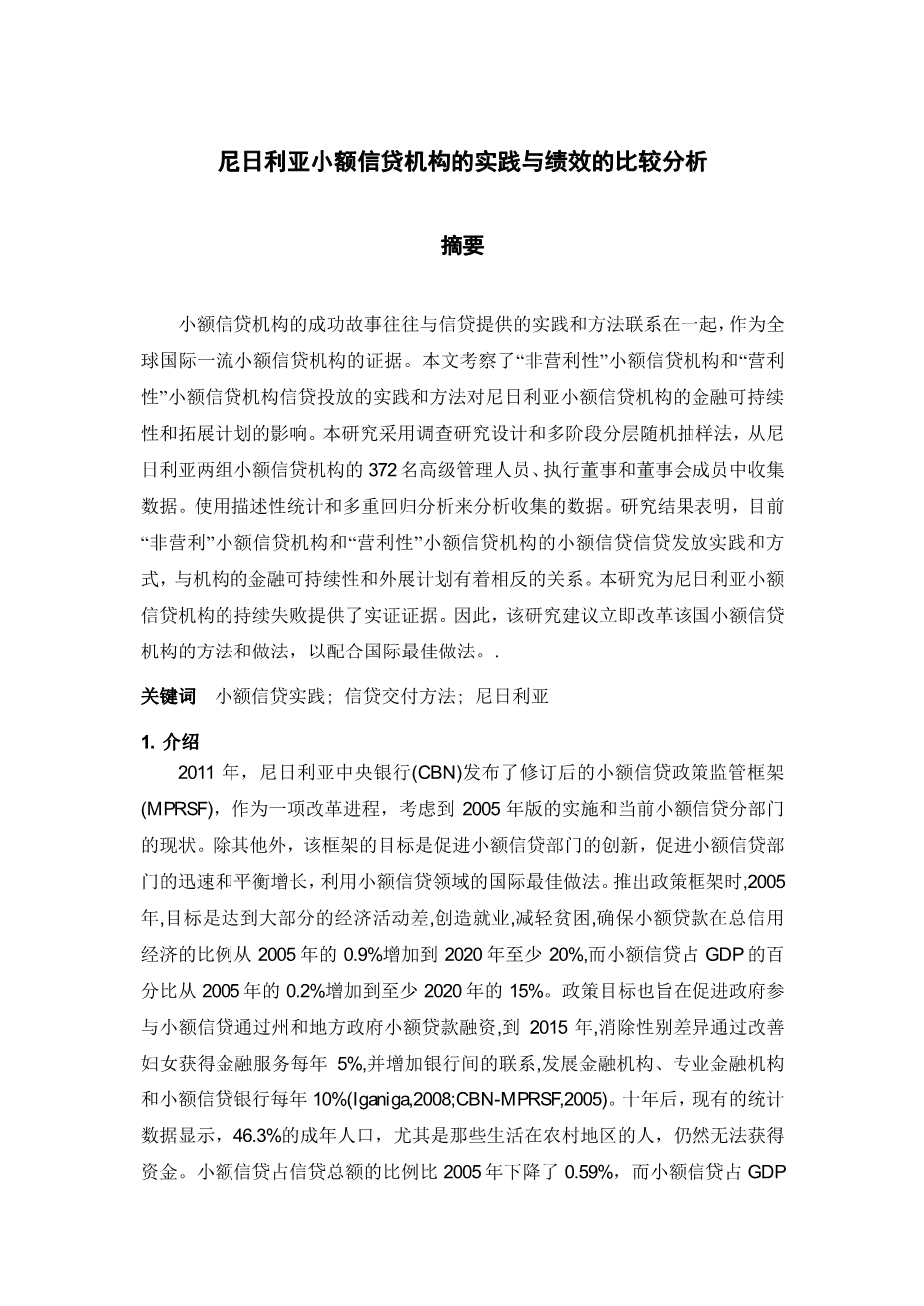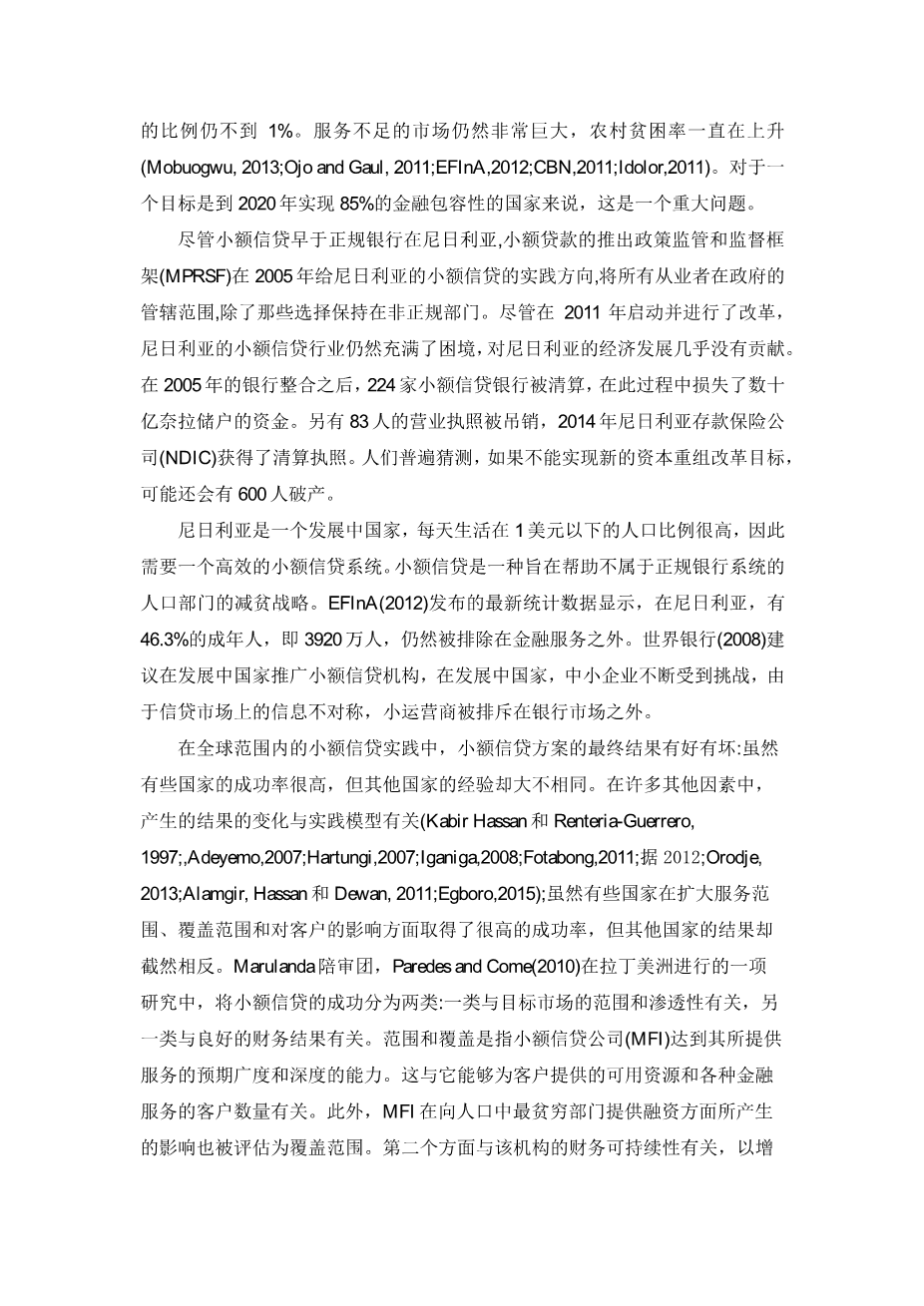A Comparative Analysis of the Practice and Performance of Microfinance Institutions in Nigeria
Abstract
The successful story of microfinance institutions is often tied to the practice and methods of credit delivery as evidence among international world class microfinance institutions across the globe. This paper examines the impact of practice and methods of credit delivery employed by ‘non- profit’ and ‘for-profit’ microfinance institutions on financial sustainability and outreach programmes of the microfinance institutions in Nigeria. The study adopts the survey research design and multi-stage stratified random sampling procedure to collect data from 372 senior management staff, managing directors and board members of microfinance institutions of both groups in Nigeria. Data collected was analysed using descriptive statistics and multiple regressions analysis. The findings suggest that the current practice and methods of credit delivery of microfinance in both ‘non-profit’ and ‘for-profit’ microfinance institutions have an inverse relationship with the financial sustainability and outreach programmes of the institutions. This study provides empirical evidence for the incessant failure of microfinance institutions in Nigeria. The study therefore recommends an immediate overhaul of the methodology and practice of microfinance institutions in the country to align with international best practice.
Keywords Microfinance Practice, credit delivery methods, Nigeria
1. Introduction
In 2011, the Central Bank of Nigeria (CBN) released the revised Microfinance Policy Regulatory and Supervisory Framework (MPRSF) as a reform process taking cognizance of the past six years’ implementation of the 2005 edition and the current state of the microfinance subsector. The aim of the framework, among other things, is to promote innovations and enhance rapid and balanced growth of the microfinance sector, leveraging on international best practices in microfinancing. In 2005, when the policy framework was launched, the target was to reach the majority of the economically active poor, generate employment, alleviate poverty, ensure that the percentage of microcredit in total credit to the economy increased from 0.9% in 2005 to at least 20% by 2020, and percentage of microcredit to GDP increased from 0.2% in 2005 to at least 15% in 2020. The policy target also intended to promote government participation in microfinancing through state and local government micro-credit financing by 2015, eliminate gender disparity by improving women’s access to financial services by 5% annually, and increase the number of linkages among banks, development finance institutions, specialized finance institutions and microfinance banks by 10% annually (Iganiga, 2008; CBN-MPRSF, 2005). Ten years later, available statistics show that 46.3% of the adult population, particularly those living in the rural areas, still lack access to finance. Microcredit as a percentage of total credit stood at 0.59% worse than the 2005 position, while microcredit as a percentage of GDP is still less than 1%. The under-served market is still very huge and rural poverty rate has been on the increase (Mobuogwu, 2013;Ojo and Gaul, 2011; EFInA, 2012; CBN, 2011; Idolor, 2011). These are major concerns for a nation that is aiming to achieve 85% financial inclusion by 2020.
Even though microfinance predates formal banking in Nigeria, the launch of the Microfinance Policy Regulatory and Supervisory Framework (MPRSF) in 2005 was to give direction to the practice of microfinance in Nigeria, bringing all practitioners under the purview of the government except those who choose to remain in the informal sector. Despite the launch and subsequent reform in 2011, the microfinance industry in Nigeria has been full of woes, with little or no contribution to economic development in Nigeria. After the 2005 bank consolidation, 224 microfinance banks were liquidated, with billions of Naira of depositors’ funds lost in the process. Operating licenses of another 83 were revoked and approval to liquidate them was given to Nigeria Deposit Insurance Corporation (NDIC) in 2014. Speculation is rife that another 600 may go under if they fail to meet up with the new recapitalization reforms target.
Nigeria, being a developing country with a high percentage of people living on less than $1 per day, needs an efficient microfinance system. Microfinancing is a poverty reduction strategy targeted at reaching a sector of the population that is excluded from the formal banking system. Recent statistics released by EFInA (2012) show that 46.3% of Nigerian adults, representing 39.2 million people, are still excluded from financial services. The World Bank (2008) recommends the promotion of microfinance institutions in developing countries, where small- and medium-scale businesses are constantly challenged and small operators are shut out of the banking market due to information asymmetry in the credit market.
In the practice of microfinance across the globe, the end results of microfinance programmes have yielded mixed results: while some countries recorded a high success rate, other countries’ experience is quite different. The variation in results generated has been associated with the model of practice, among many other factors (Kabir Hassan and Renteria-Guerrero, 1997; Oke and Adeyemo, 2007; Hartungi, 2007; Iganiga, 2008; Fotabong, 2011; Acha, 2012; Orodje, 2013; Alamgir, Hassan and Dewan, 2011; Egboro, 2015); while some countries recorded high success rates in terms of outreach, coverage and impact on clients, the results in other countries are directly opposite. Marulanda, Fajury, Paredes and Come (2010), in a study carried out in Latin America, categorize success in microfinance into two groups: one has to do with scope and penetration of the target market, the other has
剩余内容已隐藏,支付完成后下载完整资料


英语译文共 11 页,剩余内容已隐藏,支付完成后下载完整资料
资料编号:[469916],资料为PDF文档或Word文档,PDF文档可免费转换为Word
以上是毕业论文外文翻译,课题毕业论文、任务书、文献综述、开题报告、程序设计、图纸设计等资料可联系客服协助查找。


